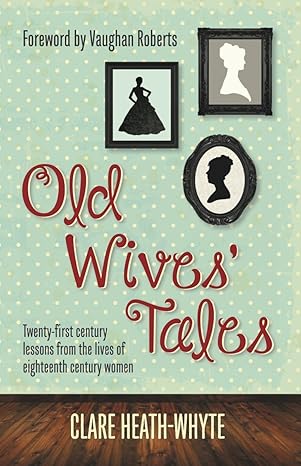Back-seat drivers?
Old Wives’ Tales by Clare Heath-Whyte


Social values and norms change over the centuries. This also applies to the Christian Church. So, as we read about the lives of seven 18th century Christian leaders’ wives, we have some difficulty relating their experiences to ours of today.
Husband’s ‘right hand’
The husbands of these wives were famous – evangelists, missionaries, founders of the Methodist movement, political activists, authors of theological works and much-loved hymns. Their wives knew each other but were generally unknown outside their circles.
Practical reasons prompted these marriages, not love. Romantic feelings were often despised as distractions from the great man’s primary calling of serving God.
When George Whitefield proposed to Elizabeth James – ‘one who would not, I think, attempt to hinder me in His work for the world’ – she was in love with another man, Howell Harris, a close friend of his. And he was also in love with her. Nevertheless, it was Howell who gave her away at the wedding.
A preacher needed a helper, a housekeeper, someone to care for women converts or impoverished female dependents. Of course he also had sexual desires and temptations, but those were not discussed. One primary duty of a wife was to produce offspring to perpetuate his high calling.
As the husband was often travelling, holding evangelistic meetings all over the country or in America, or secluded in his office writing theological books and pamphlets, his wife was often solely responsible for bringing up the many children, entertaining guests and running the household as best she could with very limited finances.
Even when she was not well, her very presence encouraged and helped John. His ministry flourished and his fame grew, particularly when the story of his conversion became a runaway bestseller. Mary supported him in the background, entertaining the many guests to the vicarage, providing a listening ear and a calming presence for her dynamic and sometimes volatile husband.
Financial hardship
Living from offerings and donations, meant such evangelists seldom had enough money:
George bought some second-hand curtains for their home and, as they could not afford any furniture, they had to borrow from a friend. George wrote to thank him: ‘I thank you a thousand times for your great generosity in lending me some furniture, having little of my own. I know who will repay you.’ Immediately after the baptism of their son, Elizabeth and the baby had to leave London to save money.
Even when officially employed by the Church, a minister’s living was uncertain. When Jonathan Edwards reprimanded some young men for misbehaving and tightened up the requirements of those wanting to take Communion, 200 members of the congregation signed a petition asking him to leave:
Jonathan, at 47 years old, with a wife and ten children to support, found himself unemployed. He wrote: ‘I am now thrown upon the wide ocean of the world and know not what will become of me and my numerous and chargeable family.’ Fortunately, Sarah was adaptable and organized moneymaking ventures for the family so that they did not starve. She and her daughters made lacework, embroidery and painted fans to be sent to market in Boston.
Faith
Most of these wives were women of deep faith, who served God and their husbands humbly and devotedly. Selina, Countess of Huntingdon, was a prime example. She grew up rich and famous. After she became a Christian, she became extremely active in promoting the Gospel, even to the point of selling her jewelry and other possessions. The Roman Catholic John Henry Newman, who objected to her evangelical beliefs, wrote:
She devoted herself, her name, her means, her time, her thoughts, to the cause of Christ. She did not spend her money on herself; she did not allow the homage paid to her rank to remain with herself: she passed these on, and offered them up to Him from whom her gifts came … She was the representative, in an evil day, of what was, then as now, lost to the Church, – of the rich becoming poor for Christ, of delicate women putting off their soft attire and wrapping themselves in sack-cloth for the kingdom of heaven’s sake.
Conclusion
Clare Heath-Whyte combines biographical accounts of these 18th century preachers’ wives with spiritual lessons for the reader. In that way, the book has a double value. However, two aspects make it difficult to adopt these characters as models:
- The status and role of a woman – especially a wife – have changed dramatically in recent generations. She is no longer her husband’s subservient ‘right hand’ but enjoys a good education, medical care and equal civil rights. She makes her own decisions and often follows a career of her choice, giving her a certain financial independence.
- For better or worse, church leaders today see their function less as aggressive evangelists winning souls for Christ at all costs and more as spiritual guides, providing a service to the community.
Times have changed. But we can always learn from history. Behind the Reformation reviews the books by Margaret Skea about Katharina von Bora, the nun who escaped and became the wife of Dr Martin Luther.


